Shuguang Cui
Sherman
Empowering Large Language Models with 3D Situation Awareness
Mar 29, 2025Abstract:Driven by the great success of Large Language Models (LLMs) in the 2D image domain, their applications in 3D scene understanding has emerged as a new trend. A key difference between 3D and 2D is that the situation of an egocentric observer in 3D scenes can change, resulting in different descriptions (e.g., ''left" or ''right"). However, current LLM-based methods overlook the egocentric perspective and simply use datasets from a global viewpoint. To address this issue, we propose a novel approach to automatically generate a situation-aware dataset by leveraging the scanning trajectory during data collection and utilizing Vision-Language Models (VLMs) to produce high-quality captions and question-answer pairs. Furthermore, we introduce a situation grounding module to explicitly predict the position and orientation of observer's viewpoint, thereby enabling LLMs to ground situation description in 3D scenes. We evaluate our approach on several benchmarks, demonstrating that our method effectively enhances the 3D situational awareness of LLMs while significantly expanding existing datasets and reducing manual effort.
Exploring Disentangled and Controllable Human Image Synthesis: From End-to-End to Stage-by-Stage
Mar 25, 2025Abstract:Achieving fine-grained controllability in human image synthesis is a long-standing challenge in computer vision. Existing methods primarily focus on either facial synthesis or near-frontal body generation, with limited ability to simultaneously control key factors such as viewpoint, pose, clothing, and identity in a disentangled manner. In this paper, we introduce a new disentangled and controllable human synthesis task, which explicitly separates and manipulates these four factors within a unified framework. We first develop an end-to-end generative model trained on MVHumanNet for factor disentanglement. However, the domain gap between MVHumanNet and in-the-wild data produce unsatisfacotry results, motivating the exploration of virtual try-on (VTON) dataset as a potential solution. Through experiments, we observe that simply incorporating the VTON dataset as additional data to train the end-to-end model degrades performance, primarily due to the inconsistency in data forms between the two datasets, which disrupts the disentanglement process. To better leverage both datasets, we propose a stage-by-stage framework that decomposes human image generation into three sequential steps: clothed A-pose generation, back-view synthesis, and pose and view control. This structured pipeline enables better dataset utilization at different stages, significantly improving controllability and generalization, especially for in-the-wild scenarios. Extensive experiments demonstrate that our stage-by-stage approach outperforms end-to-end models in both visual fidelity and disentanglement quality, offering a scalable solution for real-world tasks. Additional demos are available on the project page: https://taited.github.io/discohuman-project/.
DriveGEN: Generalized and Robust 3D Detection in Driving via Controllable Text-to-Image Diffusion Generation
Mar 14, 2025Abstract:In autonomous driving, vision-centric 3D detection aims to identify 3D objects from images. However, high data collection costs and diverse real-world scenarios limit the scale of training data. Once distribution shifts occur between training and test data, existing methods often suffer from performance degradation, known as Out-of-Distribution (OOD) problems. To address this, controllable Text-to-Image (T2I) diffusion offers a potential solution for training data enhancement, which is required to generate diverse OOD scenarios with precise 3D object geometry. Nevertheless, existing controllable T2I approaches are restricted by the limited scale of training data or struggle to preserve all annotated 3D objects. In this paper, we present DriveGEN, a method designed to improve the robustness of 3D detectors in Driving via Training-Free Controllable Text-to-Image Diffusion Generation. Without extra diffusion model training, DriveGEN consistently preserves objects with precise 3D geometry across diverse OOD generations, consisting of 2 stages: 1) Self-Prototype Extraction: We empirically find that self-attention features are semantic-aware but require accurate region selection for 3D objects. Thus, we extract precise object features via layouts to capture 3D object geometry, termed self-prototypes. 2) Prototype-Guided Diffusion: To preserve objects across various OOD scenarios, we perform semantic-aware feature alignment and shallow feature alignment during denoising. Extensive experiments demonstrate the effectiveness of DriveGEN in improving 3D detection. The code is available at https://github.com/Hongbin98/DriveGEN.
Adaptive Pruning for Large Language Models with Structural Importance Awareness
Dec 19, 2024Abstract:The recent advancements in large language models (LLMs) have significantly improved language understanding and generation capabilities. However, it is difficult to deploy LLMs on resource-constrained edge devices due to their high computational and storage resource demands. To address this issue, we propose a novel LLM model pruning method, namely structurally-aware adaptive pruning (SAAP), to significantly reduce the computational and memory costs while maintaining model performance. We first define an adaptive importance fusion metric to evaluate the importance of all coupled structures in LLMs by considering their homoscedastic uncertainty. Then, we rank the importance of all modules to determine the specific layers that should be pruned to meet particular performance requirements. Furthermore, we develop a new group fine-tuning strategy to improve the inference efficiency of LLMs. Finally, we evaluate the proposed SAAP method on multiple LLMs across two common tasks, i.e., zero-shot classification and text generation. Experimental results show that our SAAP method outperforms several state-of-the-art baseline methods, achieving 2.17%, 2.37%, and 2.39% accuracy gains on LLaMA-7B, Vicuna-7B, and LLaMA-13B. Additionally, SAAP improves the token generation speed by 5%, showcasing its practical advantages in resource-constrained scenarios.
An Efficient Occupancy World Model via Decoupled Dynamic Flow and Image-assisted Training
Dec 18, 2024Abstract:The field of autonomous driving is experiencing a surge of interest in world models, which aim to predict potential future scenarios based on historical observations. In this paper, we introduce DFIT-OccWorld, an efficient 3D occupancy world model that leverages decoupled dynamic flow and image-assisted training strategy, substantially improving 4D scene forecasting performance. To simplify the training process, we discard the previous two-stage training strategy and innovatively reformulate the occupancy forecasting problem as a decoupled voxels warping process. Our model forecasts future dynamic voxels by warping existing observations using voxel flow, whereas static voxels are easily obtained through pose transformation. Moreover, our method incorporates an image-assisted training paradigm to enhance prediction reliability. Specifically, differentiable volume rendering is adopted to generate rendered depth maps through predicted future volumes, which are adopted in render-based photometric consistency. Experiments demonstrate the effectiveness of our approach, showcasing its state-of-the-art performance on the nuScenes and OpenScene benchmarks for 4D occupancy forecasting, end-to-end motion planning and point cloud forecasting. Concretely, it achieves state-of-the-art performances compared to existing 3D world models while incurring substantially lower computational costs.
Generative Semantic Communication: Architectures, Technologies, and Applications
Dec 11, 2024



Abstract:This paper delves into the applications of generative artificial intelligence (GAI) in semantic communication (SemCom) and presents a thorough study. Three popular SemCom systems enabled by classical GAI models are first introduced, including variational autoencoders, generative adversarial networks, and diffusion models. For each system, the fundamental concept of the GAI model, the corresponding SemCom architecture, and the associated literature review of recent efforts are elucidated. Then, a novel generative SemCom system is proposed by incorporating the cutting-edge GAI technology-large language models (LLMs). This system features two LLM-based AI agents at both the transmitter and receiver, serving as "brains" to enable powerful information understanding and content regeneration capabilities, respectively. This innovative design allows the receiver to directly generate the desired content, instead of recovering the bit stream, based on the coded semantic information conveyed by the transmitter. Therefore, it shifts the communication mindset from "information recovery" to "information regeneration" and thus ushers in a new era of generative SemCom. A case study on point-to-point video retrieval is presented to demonstrate the superiority of the proposed generative SemCom system, showcasing a 99.98% reduction in communication overhead and a 53% improvement in retrieval accuracy compared to the traditional communication system. Furthermore, four typical application scenarios for generative SemCom are delineated, followed by a discussion of three open issues warranting future investigation. In a nutshell, this paper provides a holistic set of guidelines for applying GAI in SemCom, paving the way for the efficient implementation of generative SemCom in future wireless networks.
When UAV Meets Federated Learning: Latency Minimization via Joint Trajectory Design and Resource Allocation
Dec 10, 2024Abstract:Federated learning (FL) has emerged as a pivotal solution for training machine learning models over wireless networks, particularly for Internet of Things (IoT) devices with limited computation resources. Despite its benefits, the efficiency of FL is often restricted by the communication quality between IoT devices and the central server. To address this issue, we introduce an innovative approach by deploying an unmanned aerial vehicle (UAV) as a mobile FL server to enhance the training process of FL. By leveraging the UAV's maneuverability, we establish robust line-of-sight connections with IoT devices, significantly improving communication capacity. To improve the overall training efficiency, we formulate a latency minimization problem by jointly optimizing the bandwidth allocation, computing frequencies, transmit power for both the UAV and IoT devices, and the UAV's trajectory. Then, an efficient alternating optimization algorithm is developed to solve it efficiently. Furthermore, we analyze the convergence and computational complexity of the proposed algorithm. Finally, numerical results demonstrate that our proposed scheme not only outperforms existing benchmark schemes in terms of latency but also achieves training efficiency that closely approximate the ideal scenario.
Towards Flexible 3D Perception: Object-Centric Occupancy Completion Augments 3D Object Detection
Dec 06, 2024Abstract:While 3D object bounding box (bbox) representation has been widely used in autonomous driving perception, it lacks the ability to capture the precise details of an object's intrinsic geometry. Recently, occupancy has emerged as a promising alternative for 3D scene perception. However, constructing a high-resolution occupancy map remains infeasible for large scenes due to computational constraints. Recognizing that foreground objects only occupy a small portion of the scene, we introduce object-centric occupancy as a supplement to object bboxes. This representation not only provides intricate details for detected objects but also enables higher voxel resolution in practical applications. We advance the development of object-centric occupancy perception from both data and algorithm perspectives. On the data side, we construct the first object-centric occupancy dataset from scratch using an automated pipeline. From the algorithmic standpoint, we introduce a novel object-centric occupancy completion network equipped with an implicit shape decoder that manages dynamic-size occupancy generation. This network accurately predicts the complete object-centric occupancy volume for inaccurate object proposals by leveraging temporal information from long sequences. Our method demonstrates robust performance in completing object shapes under noisy detection and tracking conditions. Additionally, we show that our occupancy features significantly enhance the detection results of state-of-the-art 3D object detectors, especially for incomplete or distant objects in the Waymo Open Dataset.
MVImgNet2.0: A Larger-scale Dataset of Multi-view Images
Dec 02, 2024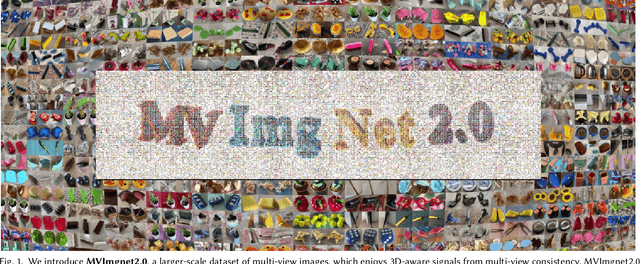
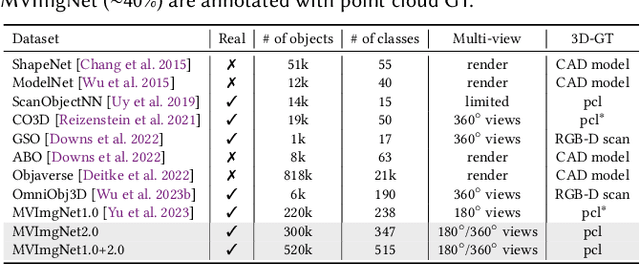
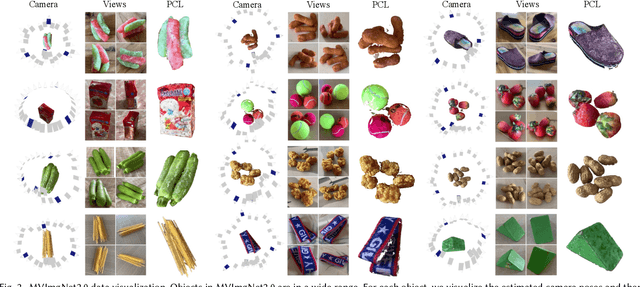
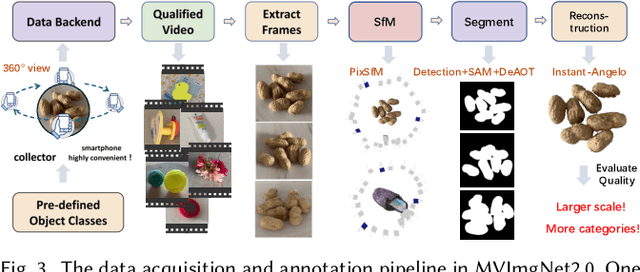
Abstract:MVImgNet is a large-scale dataset that contains multi-view images of ~220k real-world objects in 238 classes. As a counterpart of ImageNet, it introduces 3D visual signals via multi-view shooting, making a soft bridge between 2D and 3D vision. This paper constructs the MVImgNet2.0 dataset that expands MVImgNet into a total of ~520k objects and 515 categories, which derives a 3D dataset with a larger scale that is more comparable to ones in the 2D domain. In addition to the expanded dataset scale and category range, MVImgNet2.0 is of a higher quality than MVImgNet owing to four new features: (i) most shoots capture 360-degree views of the objects, which can support the learning of object reconstruction with completeness; (ii) the segmentation manner is advanced to produce foreground object masks of higher accuracy; (iii) a more powerful structure-from-motion method is adopted to derive the camera pose for each frame of a lower estimation error; (iv) higher-quality dense point clouds are reconstructed via advanced methods for objects captured in 360-degree views, which can serve for downstream applications. Extensive experiments confirm the value of the proposed MVImgNet2.0 in boosting the performance of large 3D reconstruction models. MVImgNet2.0 will be public at luyues.github.io/mvimgnet2, including multi-view images of all 520k objects, the reconstructed high-quality point clouds, and data annotation codes, hoping to inspire the broader vision community.
* ACM Transactions on Graphics (TOG), SIGGRAPH Asia 2024
Generative Semantic Communication for Joint Image Transmission and Segmentation
Nov 27, 2024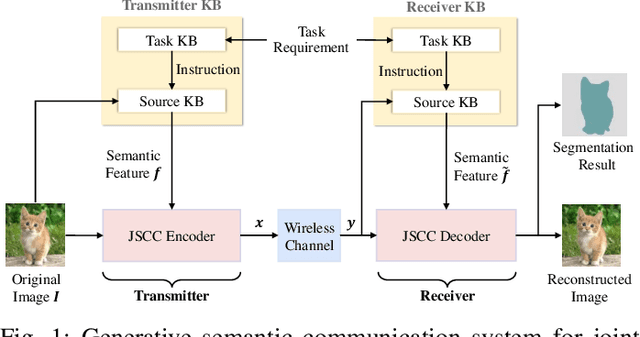
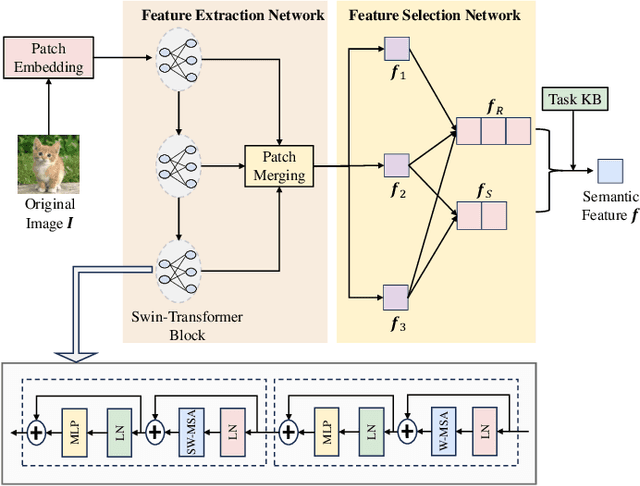
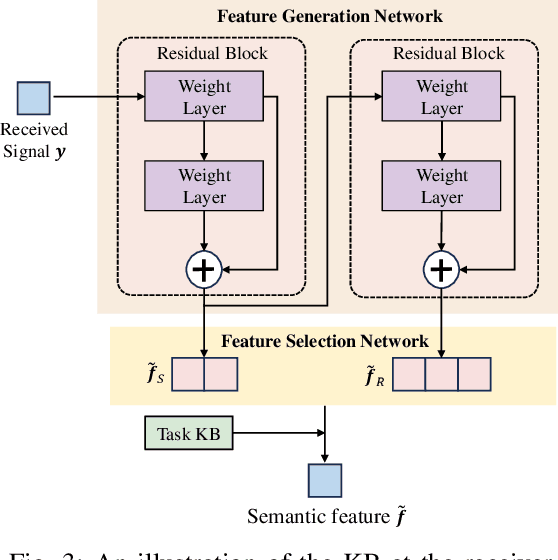
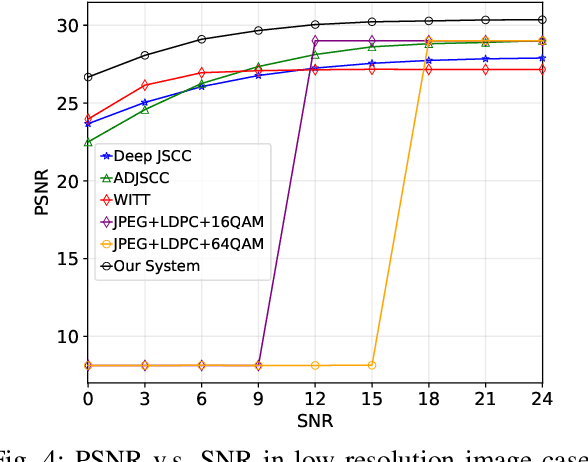
Abstract:Semantic communication has emerged as a promising technology for enhancing communication efficiency. However, most existing research emphasizes single-task reconstruction, neglecting model adaptability and generalization across multi-task systems. In this paper, we propose a novel generative semantic communication system that supports both image reconstruction and segmentation tasks. Our approach builds upon semantic knowledge bases (KBs) at both the transmitter and receiver, with each semantic KB comprising a source KB and a task KB. The source KB at the transmitter leverages a hierarchical Swin-Transformer, a generative AI scheme, to extract multi-level features from the input image. Concurrently, the counterpart source KB at the receiver utilizes hierarchical residual blocks to generate task-specific knowledge. Furthermore, the two task KBs adopt a semantic similarity model to map different task requirements into pre-defined task instructions, thereby facilitating the feature selection of the source KBs. Additionally, we develop a unified residual block-based joint source and channel (JSCC) encoder and two task-specific JSCC decoders to achieve the two image tasks. In particular, a generative diffusion model is adopted to construct the JSCC decoder for the image reconstruction task. Experimental results demonstrate that our multi-task generative semantic communication system outperforms previous single-task communication systems in terms of peak signal-to-noise ratio and segmentation accuracy.
 Add to Chrome
Add to Chrome Add to Firefox
Add to Firefox Add to Edge
Add to Edge